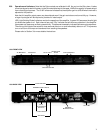13
Connect the amplifier input to Ch. 1 only, and use only the Ch. 1 Gain control, which now controls the entire
amplifier. Do not feed another input into Channel 2. The Ch. 2 Gain control should be kept off for safety. An
8 or 16 ohm speaker load should be connected across the two red speaker terminals, using the red terminal of
Ch. 1 as the “+” or “hot” terminal, the red terminal of Ch. 2 is the “-” or “common” terminal.
Mono Bridge Precautions
a. Minimum load impedance is 8 ohms, which will be the equivalent, to the amp, of 4 ohms per channel. If a four-
ohm load is used, the amp will have to work very hard and may overheat.
b. Both sides of the speaker cable are “hot” or active. Be sure there is no ground or other circuit connected to
either side of the speaker cable.
c. If the parallel-channel switches (#5,6, see Section 3.51) are switched on,the signal into Ch. 2 will cancel the
mono-bridge signal. To prevent this, and still permit patching to additional amps, keep the Gain for Ch. 2 fully
off.
3.6 SPEAKER CONNECTIONS
3.61 Speaker Terminals Red and Black 5-way binding posts, on standard 3/4-inch centers, are located on the rear
of the chassis of all Series One amplifiers.
The 1100 features a pair of standard 1/4" headphone jacks on the front panel. They are connected to the speaker
outputs of the amplifier through a resistive pad that prevents excessive power levels from damaging the
headphones. Always fully turn down the Gain controls before plugging in headphones to prevent accidental
exposure to excessive sound levels that can cause permanent hearing damage.
3.62 Terminal Polarity The Red binding post carries the positive or “hot” speaker output. The Black binding post is
the ground return for the speaker.
3.63 Speaker Cables In order to obtain the full benefit of the high power and high damping factor of the amplifier, the
user must avoid cable losses. The best way is to use the heaviest-gauge, finely stranded wiring possible. 12-
gauge speaker cable is available, and heavier gauge “specialty” cable is sold by audio dealers.
3.64 Cable Termination A major problem with heavy-gauge cables is that the ends are too large to fit most speaker
terminals. Usually, it is necessary to install spade lugs on each end, which must be soldered or soundly crimped.
These must then be screwed firmly under the binding posts. Dual banana plugs are more convenient for portable
systems, and will normally accept at least 12-gauge wires.
3.65 Cable Polarity Be sure to observe correct polarity at both the speaker and amplifier end. Most present-day
speaker cable is color-coded or polarized in some way. Adopt a consistent wiring convention and stick to it. We
suggest Black for “Com” (ground or negative) and Red for “Spkr” (hot or positive). These colors match the binding
posts. By the same logic, we can assign the copper-colored wire to the Red (“Spkr”) terminal, and the silver-
colored wire to the Black (“Com”) terminal.
3.66 Bridged Mono Please see Section 3.52 for the bridged-mono speaker connection.
3.67 Speaker Impedance The Series One amplifiers have adequate current capability to fully drive loads down to two
ohms. However, many high-performance “8-ohm” loudspeakers, especially multiple-way systems with passive
crossovers, have impedances at some frequencies which are far lower than the average rating. An impedance
minimum of 2 ohms or less is not uncommon. For this reason, speaker impedance curves should be consulted
before connecting speakers in parallel.
We would expect the amplifier to do an outstanding job with any 8-ohm, full-range speaker system, and we expect
equally outstanding performance when driving 4-ohm loads without passive crossovers (as part of a bi-or-tri-
amped system, for instance). 2-ohm loads should be approached with caution, as there is no further margin for
impedance dips. The amp should not be damaged, but high-power operation into reactive 2-ohm loads may result
in overheating or excessive AC current consumption, causing shutdowns. In addition, some power may be lost
at those frequencies where the impedance dips below 2 ohms. For these reasons, operation with 2-ohm loads
should be tested thoroughly before putting into use.
3.69 Speaker Wire Table The following table is presented to assist in selection of appropriate speaker wire. Power
losses and net damping factors (including the amplifier, with a Damping Factor of 200) are shown for a variety of
lengths and gauges. Note that loss of power and damping factor are more severe for longer lengths, lower
impedance loads, and higher (thinner) gauges. One should maintain a minimum damping factor of 20, and
preferably 50 for high-quality systems; this will automatically prevent significant power loss. Although a power


















